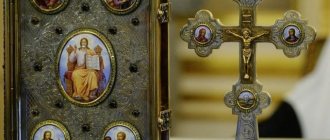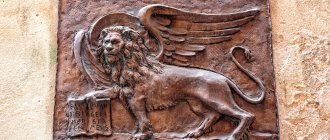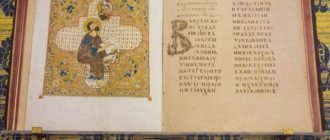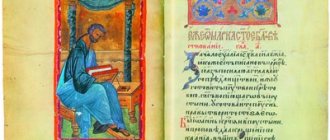I dedicate to My Father, My Mother, My brothers and sisters, My wife, My children, My mother-in-law, all My close and distant relatives
© Arkady Kazansky, 2016
Editor
Irina Kazanskaya
Created in the intellectual publishing system Ridero
The keys to the New Testament are hidden in the book that closes it: the Revelation of John the Theologian (Apocalypse). The Apostle and Evangelist John the Theologian, shortly before his death, writes this greatest book with an extremely important goal for him and all of us: to convey to descendants the true time of writing the New Testament and, consequently, the true time of the life of John the Theologian himself, the Gospel events associated with him, the true the place where these events took place, with the active participation of John the Theologian himself.
Only by standing up at the right time, in the right place, and looking around, do you begin to understand the picture that appears before you. The people of the described era, the cities, the countries surrounding the witness of the events and the events themselves emerge from the “darkness of centuries” and clearly appear in their simplicity and their grandeur to the gaze of an unbiased observer.
Having determined from the stars, brilliantly described by John the Theologian, that this is happening in the 15th century, I find the real historical person who wrote the Revelation. This is not a fisherman or a shepherd, as the apostles of Jesus Christ are usually portrayed as. The writer signs with his real name - John VIII Palaiologos - Emperor of Byzantium, who ruled in Constantinople in the first half of the 15th century. And I find confirmation of this in the form of a painting by an artist of that time.
It seems how far this is from the Nativity of Christ. But, abandoning these thoughts, moving after John the Theologian to the 15th century, I immediately find a great man who was born 70 years before the fall of the capital of John VIII Palaiologos (realizing that the first historical fall of the great city occurs in the 70th year of Christ). In the Bible this city is called Jerusalem, in reality it is: the capital of Byzantium is the city of Constantinople, John the Theologian in Revelation calls it Babylon.
The second book of the first volume is devoted to the analysis of the second greatest work of John the Theologian - the Gospel of John. A thorough analysis of the Gospel allows us to restore all the characters of the Gospel events: the rulers, the apostles, the Virgin Mary, the Magi and the real picture of the actions described in the New Testament.
Authorship
The writer of the Apocalypse himself calls himself “John” (Rev. 1:1, 4, 9). According to the general belief of the Church, it was St. the Apostle John, the beloved disciple of Christ, who received the distinctive title of “Theologian” for the height of his teaching about God the Word, to whose inspired pen belongs the 4th canonical Gospel and 3 conciliar epistles. This belief of the Church is justified both by the data indicated in the Apocalypse itself and by various internal and external signs.
The writer of the Apocalypse calls himself “John” at the very beginning, saying that he was given the “Revelation of Jesus Christ” (1:1). Further greeting the seven churches of Asia Minor, he again calls himself “John” (1:4). He goes on to say about himself, again calling himself “John,” that he was “on the island called Patmos for the word of God and for the testimony of Jesus Christ” (1:9). From Apostolic history it is known that it was St. John the Theologian was imprisoned on Fr. Patmos. And finally, ending the Apocalypse, the writer again calls himself “John” (22:8). In verse 2 of chapter 1, he calls himself a witness of Jesus Christ (cf. 1 John 1:1-3). The opinion that the Apocalypse was written by some “presbyter John” is completely untenable. The very identity of this “Presbyter John” as a person separate from the Apostle John is rather doubtful. The only evidence that gives reason to talk about “prester John” is a passage from the work of Papias, preserved by the historian Eusebius. It is extremely vague and gives room only to guesses and assumptions that contradict one another. The opinion that attributed the writing of the Apocalypse to John-Mark, that is, to the Evangelist Mark, is not based on anything. Even more absurd is the opinion of the Roman presbyter Caius (III century) that the Apocalypse was written by the heretic Cerinthos. However, many believe that Caius, the presbyter of Rome, does not consider the Apocalypse to be the creation of the heretic Cerinthos, as some infer from his words, for Caius is not talking about a book called “Revelation,” but about “revelations.” Eusebius himself, who quotes these words from Caius, does not say a word about Cerinthus being the author of the book of the Apocalypse. Blessed Jerome and other fathers, who knew this place in the work of Kai and recognized the authenticity of the Apocalypse, would not have left it without objection if they considered the words of Kai to relate to the Apocalypse of St. John the Theologian.
The second proof that the Apocalypse belongs to the Apostle John the Theologian is its similarity to the Gospel and the Epistles of John, not only in spirit, but also in style, and especially in some characteristic expressions. So, for example, the apostolic preaching is called here “testimony” (Rev. 1:2-9; 20:4 cf. John 1:7, 3:11, 21:24; 1 John 5:9-11). The Lord Jesus Christ is called “the Word” (Rev. 19:13 cf. John 1:1-14 and 1 John 1:1) and “Lamb” (Rev. 5:6 and 17:14 cf. John 1: 36). The prophetic words of Zechariah: “And they will see Him who has broken the blood” (12:10) both in the Gospel and in the Apocalypse are given equally according to the translation of the 70 (Rev. 1:7 and John 19:37). Some found that the language of the Apocalypse differs from the language of other writings of St. Apostle John. This difference is easily explained both by the difference in content and by the circumstances of the origin of the writings of St. Apostle. St. John, although he spoke Greek, but, being in captivity, far from the living spoken Greek language, naturally put the stamp of the strong influence of the Hebrew language on the Apocalypse, as a natural Jew. For an unprejudiced reader of the Apocalypse, there is no doubt that its entire content bears the stamp of the great spirit of the Apostle of love and contemplation.
All ancient and later patristic testimonies recognize the author of the Apocalypse as St. John the Theologian. His disciple St. Papias of Hierapolis calls “Elder John” the writer of the Apocalypse, by which name St. himself calls himself. The Apostle in his epistles (1 John 1 and 3 John 1). The testimony of St. Justin Martyr, who even before his conversion to Christianity lived for a long time in Ephesus, the city where the great Apostle lived and rested for a long time. Many St. the fathers cite passages from the Apocalypse, as from a divinely inspired book belonging to St. John the Theologian. These are: St. Irenaeus of Lyons, disciple of St. Polycarp of Smyrna, disciple of St. John the Evangelist, St. Hippolytus of Rome, a student of Irenaeus, who even wrote an apology for the Apocalypse. Clement of Alexandria, Tertullian and Origen also recognize St. Apostle John, writer of the Apocalypse. The Monk Ephraim the Syrian, Epiphanius, Basil the Great, Hilary, Athanasius the Great, Gregory the Theologian, Didymus, Ambrose of Milan, Augustine of Hippo, and Jerome of Stridon are equally convinced of this. 33rd rule of the Council of Carthage, attributing the Apocalypse to St. John the Theologian, places it among other canonical books. The absence of the Apocalypse in Pescito's translation is explained solely by the fact that this translation was made for liturgical reading, and the Apocalypse was not read during the divine service. In canon 60 of the Council of Laodicea, the Apocalypse is not mentioned, since the mysterious content of the book did not allow anyone to recommend a book that could give rise to false interpretations.
Fifth part. Signs of the Apocalypse
Numerous disasters befall people because of their sins and unbelief. This is announced by the trumpets of angels, seven in number. The horrors and disasters that befell humanity are described.
This is what the end of the world might look like
The first angel sounded the trumpet - and bloody hail with fire fell to the ground, green grass and a third of the trees died.
The second angel sounded his trumpet , and a large fiery mountain fell into the sea, bringing death to many sea animals and a third of the ships. the water turned the color of blood.
After the sound of the third angelic trumpet, an unprecedentedly large star named “wormwood” fell from the sky, poisoned the water and killed many people who drank it.
The fourth angel sounded the trumpet - and a solar eclipse will occur, the third part of it, the stars and the moon will go out. And the day became shorter by a third.
“And I saw and heard one angel flying in the middle of heaven and saying with a loud voice: Woe, woe, woe to those who dwell on the earth because of the rest of the trumpet voices of the three angels that will sound!”
(Rev.8:13)
The voice of the fifth angel's trumpet announced the fall of a star from heaven. She was given the power to open the “deep pit,” from which smoke came out, and from the smoke appeared terrible locusts.
The monstrous insects have a human face, female hair and sharp teeth. They will not harm either the grass or the trees, but for five months they will torment those who do not have a seal on their forehead - sinners.
“In those days people will seek death, but will not find it; They will wish to die, but death will flee from them.”
(Rev.9:6)
The sixth angel sounded his trumpet and the seer saw an innumerable cavalry army; fire, smoke and brimstone burst out of the horses’ mouths and destroyed a third of the people.
After the sound of the seventh angel's trumpet, an earthquake will occur and seven thousand people will die.
“...in those days when the seventh angel proclaims, when he blows his trumpet, the mystery of God will be fulfilled, as He preached to His servants the prophets.”
(Rev. 10:7)
Great dragon, ancient serpent
The Apostle John received a book from an Angel and was endowed with the power to prophesy. The text of the Apocalypse of John the Theologian says that after these seven signs all people will be divided into two warring camps - Good and Evil. The forces of Good will be concentrated in the Church of Christ, and the forces of Evil - in the kingdom of the Beast-Antichrist.
Time and place of writing
We do not have exact data about the time of writing of the Apocalypse. An ancient legend indicates the end of the century for this. Yes, St. Irenaeus of Lyons writes: “The Apocalypse appeared shortly before this and almost in our time, at the end of the reign of Domitian.”
(“Against Heresies” 5:30). The church historian Eusebius reports that contemporary pagan writers also mention the exile of St. Apostle John to Patmos for his testimony about the Divine Word and refer this event to the 15th year of the reign of Domitian (95-96 AD). Clement of Alexandria, Origen and Blessed Jerome of Stridon also say the same. The church writers of the first three centuries also agree in indicating the place where the Apocalypse was written, which they recognize as the island of Patmos, mentioned by the Apostle himself as the place where he received revelations (1:9-10).
But after the discovery of the Syriac translation of the Apocalypse of the 6th century (“Pokoke”), where the inscription names Nero instead of Domitian, many began to attribute the writing of the Apocalypse to the time of Nero (the 60s AD). St. Hippolytus of Rome also attributes the exile to St. John on Fr. Patmos to Nero. They also find that it is impossible to attribute the time of writing the Apocalypse to the reign of Domitian because, judging by verses 1-2 of the 11th chapter of the Apocalypse, the Jerusalem temple was not yet destroyed, since in these verses they see a prediction about the future destruction of the temple, which under Domitian it was already accomplished. References to Roman emperors, which some see in the 10th art. Chapter 17, comes closest to the successors of Nero. They also find that the number of the beast (13:18) can be found in the name of Nero: “Nero Caesar” - 666. The very language of the Apocalypse, full of Hebraisms, also, according to some, indicates its earlier date in comparison with the 4th Gospel and the Epistles St. John's origin. Nero's full name was: “Claudius Nero Domitius,” as a result of which it was possible to confuse him with the emperor who reigned later. Domitian. According to this opinion, the Apocalypse was written about two years before the destruction of Jerusalem, that is, in the year A.D.
But it is objected to that the state of Christian life, as it appears in the Apocalypse, speaks for a later date. Each of the seven churches in Asia Minor to which St. John, already has its own history and one way or another determined direction of religious life: Christianity in them is no longer in the first stage of purity and truth - false Christianity is trying to take a place in them along with the true one. All this suggests that the activities of St. The Apostle Paul, who preached for a long time in Ephesus, was a thing of the long past. This point of view, based on the testimony of St. Irenaeus and Eusebius, dates the time of writing the Apocalypse to the years. according to R. X.
It is very difficult to accept the opinion of St. Epiphanius, who says that St. John returned from Patmos under Emperor Claudius (41-54). Under Claudius there was no general persecution of Christians in the provinces, but only the expulsion of Jews from Rome, among whom there could have been Christians.
It is also incredible that the Apocalypse was written at an even later time, under the emperor Trajan (-108), when St. John died. Regarding the place where the Apocalypse was written, there is also an opinion that it was written in Ephesus, after the Apostle returned there from exile, although the first opinion is much more natural that the message to the churches of Asia Minor contained in the Apocalypse was sent precisely from Patmos. It is also difficult to imagine that St. The apostle would not have fulfilled the command to write everything he saw immediately (1:10-11).
Seven churches
John's first vision was of the Son of Man (Jesus Christ) in the midst of the seven golden lampstands, which symbolize the seven churches. Through the lips of John, God addresses each of them, characterizing its essence and giving it promises. These seven represent the one Church at different times of its existence. The first, Ephesus, is its initial stage, the second, in Smyrna, characterizes the Christian church during the period of persecution, the third, Pergamon, corresponds to the times when God’s assembly became too worldly. The fourth - in Thyatira - personifies the church, which has departed from God's truths and turned into an administrative apparatus. Bible scholars say it corresponds to the medieval Roman Catholic religious system. While the fifth church in Sardis recalls the reformation of Martin Luther. The gathering of believers in Philadelphia symbolizes a return to the truth that all who have been redeemed by the blood of Christ are members of His Universal Church. The seventh, Laodicea, represents the times when believers “faded” in their zeal, becoming “neither cold nor hot.” This kind of church makes Christ sick, he is ready to “vomit it out of his mouth” (Rev. 3:16).
Church Views on the Contents of Revelation
Most of the Church Fathers who interpreted the sacred books of the New Testament view the Apocalypse as a prophetic picture of the last times of the world and the events that are about to take place before the Second Coming of Christ to earth and at the opening of the Kingdom of Glory, prepared for all true believing Christians. Despite the darkness under which the mysterious meaning of this book is hidden and as a result of which many unbelievers tried in every possible way to discredit it, the deeply enlightened fathers and God-wise teachers of the Church have always treated it with great reverence.
Yes, St. Dionysius of Alexandria writes: “The darkness of this book does not prevent one from being surprised by it. And if I don’t understand everything about it, it’s only because of my inability. I cannot be a judge of the truths contained in it, and measure them by the poverty of my mind; Guided more by faith than by reason, I find them only beyond my understanding.”
Blessed Jerome of Stridon speaks in the same way about the Apocalypse: “It contains as many sacraments as there are words. But what am I saying? Any praise for this book would be beneath its dignity.”
However, patristic thought is not limited to understanding the Apocalypse as a prophecy only about the last times. There is a fairly widespread opinion that the Apocalypse tells about the fate of the Church of Christ and the world, starting with the founding of the Church by the Savior, i.e. since apostolic times. “When the Church was founded by the apostles, it was necessary to reveal how it would spread and what perfection it would reach in the end, in order to arm the preachers of the faith against worldly temptations.”
(Trouble the Hon.). There is an opinion that the seven churches of the Apocalypse mean seven periods in the life of the entire Church of Christ from its foundation to the end of the world [1].
Some see in the Apocalypse also a synopsis of the entire biblical history from the creation of the world to its demise. Much less common is the interpretation of the narrative of the Revelation of John the Theologian as a story about the fate of individual nations or even each person individually.
Life of John the Evangelist
According to the Gospel of Matthew, John the Evangelist, son of Zebedee, together with his brother James, left their family and became a disciple of Jesus Christ.
From that moment on, he was not separated from the teacher and witnessed numerous miracles performed by him. It was John who took care of the Virgin Mary, like a devoted son, after the execution of Jesus Christ. When the Dormition of the Most Holy Theotokos took place, the apostle, together with his disciple Prokhor, left Jerusalem to preach Christianity in distant lands and islands.
John the Theologian
On the way, they had to endure many trials: a shipwreck, persecution by the authorities, hunger, cold and disbelief in his words. He was captured and tortured, but the Lord performed a miracle, and John the Theologian remained unharmed.
Then, by decision of the authorities, he was exiled to a remote island called Patmos. It was there that he heard and wrote down the Revelation. During his long life, the holy apostle performed many miracles. He was the only one who lived more than a hundred years and outlived all the other disciples of Christ.
Artists usually depict the holy apostle as a man of advanced years, in red clothes with an inkwell, a book and a pen.
Often there is an eagle nearby, a symbol of the high flight of his thoughts, or an angel. There are also images of John at a young age.
Liturgical use
The Apocalypse is the only book of the New Testament that is not read at the Liturgy. This must be due to the fact that in ancient times the reading of the Holy Scriptures during worship was always accompanied by its interpretation, and the Apocalypse is too difficult to interpret. This also explains its absence in the Syriac translation of Peshito, which was intended specifically for liturgical use. As proven by researchers, the Apocalypse was originally on the Peshito list and was removed from there after the time of Ephraim the Syrian, for St. Ephraim the Syrian cites the Apocalypse in his writings as the canonical book of the New Testament and widely uses it in his inspired teachings.
According to the Typikon, the Apocalypse is read during the all-night vigil along with the apostolic epistles after the consecration of the loaves of bread at litia in the period from the week of All Saints to the week of Easter. The so-called “Great Reading” is the only moment in the service where the Apocalypse can be read.
Typikon's instructions regarding the reading of the Apocalypse:
“Be aware: from the week of Holy Pascha, even until the week of all saints, with the blessing of the loaves, the Acts of the Apostles are revered.
In the remaining weeks of the entire summer, the seventh conciliar epistles of the Apostles, and the fourteen epistles of the holy Apostle Paul, and the revelation of the holy Apostle John the Theologian are venerated” (Chapter 2, first “see”). “According to the Trisagion, the troparion of the Apostle is written twice: written at the small vespers. and the Virgin Mary, once, and the blessing of the loaves: and reading in the revelation of the apostles"
(Chapter 48, May 8, Old Art., the day of remembrance of “the holy, glorious, all-validated apostle and evangelist, beloved confidant, virgin, John the Theologian”).
_"From this week we begin honoring the seven conciliar epistles at the weekly matins, and the 14 epistles of the holy Apostle Paul. Revelation of John the Theologian. Let us honor them at the weekly vigils, before other readings, until the great holy week of Easter. In the 50th, the entire Acts of the Saints is honored by the Apostle in weeks, as prescribed” (Chapter 50, Sunday of All Saints, the first “see”).
Thus, when distributing readings in the period from All Saints Sunday to Easter, the period of reading Revelation falls on Great Lent (with the exception of the day of remembrance of the Apostle John).
Revealing God's Secret
Sometimes this book is called the Apocalypse, since this is how the word “Revelation” sounds in translation from Greek. It would be a mistake to think that God's Revelation is contained only in this final book of Holy Scripture. The entire Bible is an initiation into the mysteries of God's plan. The last book is the completion, a generalization of all Divine truths, “sown” in the very first biblical book - Genesis, and consistently developing in subsequent chapters of the Old, and especially the New Testament.
The end of old times
These visions are followed by images of seven bowls of wrath pouring out on an unrepentant Earth. Satan deceives sinners to come into battle with Christ. Armageddon occurs - the last battle, after which the “ancient serpent” is thrown into the abyss and imprisoned there for a thousand years. John then shows how the chosen saints rule the earth with Christ for a thousand years. Then Satan is released to deceive the nations, the final rebellion of people who have not submitted to God takes place, the judgment of the living and the dead and the final death of Satan and his followers in the lake of fire.
Three Harvests
The seer then talks about two beasts that emerged from the sea (Antichrist) and from the earth (False Prophet). This is the devil's attempt to seduce those living on earth. Deceived people accept the number of the beast - 666. Next, it talks about three symbolic harvests, personifying one hundred and forty-four thousand righteous people who were lifted up to God before the great tribulation, righteous people who heard the gospel during the tribulation and were caught up to God for this. The third harvest is the Gentiles thrown into the “press of the wrath of God.” The appearance of Angels takes place, bringing the Gospel to the people, announcing the fall of Babylon (a symbol of sin), warning those who worship the beast and accepted its seal.








